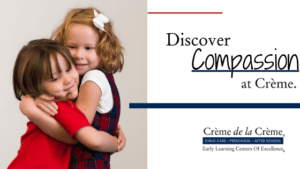
Every parent hopes to raise a child that is socially intelligent and apt to help others in need, but how does that happen, and how can parents and teachers promote prosocial behavior in their children at home and school? What are the right expectations?
Caregivers lay the foundation for children’s emotional repertoire, beginning with touch, facial expressions and speech. As children grow and their brains mature, they begin to recognize more sophisticated aspects of human nature that heavily rely on their observations of the world around them, making the environment a key player in the trajectory of their social and emotional growth. This illustrates the importance of adults’ intentional interactions to help children develop prosocial behaviors.
Altruism cannot be expected in the early years since they must first grow through stages of moral development in a fashion that correlates with their cognitive capacities. One-year old children can mimic expressions they observe, while 2-year olds relish in the positive reinforcements they receive after offering an unsolicited present, like a flower for Mommy (a reward for their action). Three-year old children begin to recognize intentionality in actions of others and assign a “good” or “bad” label to that behavior. Four-year old children begin to develop resilience, humor and empathy. The complexities of their actions reflect their ability to recognize and manipulate cause and effect. This is why cognition and emotional growth are intertwined in the early years and inappropriate expectations can stunt natural progressions.
Compassion is an altruistic feeling that is modeled by adults, and tends to be a frequent topic of discussion during the holiday season. Direct modeling includes explicit conversations about what others do or do not have or how it feels and what to do when they see someone in need. Explicit actions such as volunteering or advocating are also effective. Indirect modeling is when children casually observe reactions and actions toward others for the purpose of helping, making someone else happy, or comforting.
This holiday season, give a gift to your children by taking the time to be explicit about what it looks like to help others, model what it means to make a difference in someone else’s life, and let them observe you showing compassion toward others in need. These observations will directly influence their cognition and guide them toward acting on behalf of others.
On behalf of Crème, I want to express to you our gratitude for allowing us to be part of your children’s lives, directly and indirectly. It’s an honor we do not take lightly and one we understand will help shape your future altruistic child.
Dr. Masek
VP of Education

